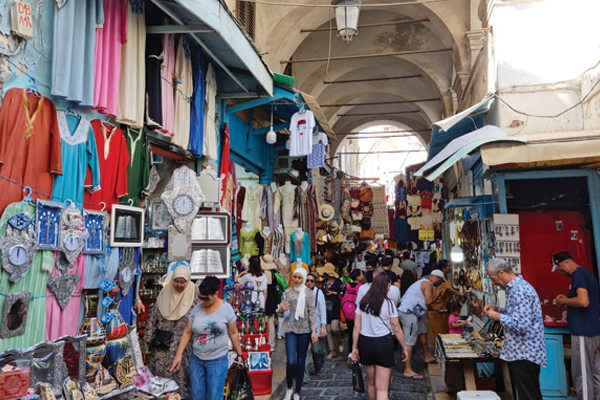-
China
-
Germany
-
United Arab Emirates
-
United States

S$170.18b
Total bilateral trade in goods with Singapore (2024)
Population (2024)
1.4b
Currency
Chinese yuan
GDP (2024)
US$18.74t
GDP growth (2024)
5.0%
GDP per capita (2024)
US$13,303.1
Global competitiveness index (2024)
14th
Explore a myriad of opportunities in a fast-growing healthcare market
With a rapidly aging population and declining birth rate, China faces an acute healthcare challenge. There is a huge opportunity for healthcare & biomedical companies to play a part as China continues to develop and improve its healthcare ecosystem, with the growing healthcare market expected to hit RMB16 trillion (~S$3.29 trillion) in 2030.-
A thriving healthcare industryChina currently accounts for around 20% of the global medical device market, and this is expected to increase. To accelerate the growth of its emerging medtech industry, China has been making rapid regulatory reforms since 2015. This has seen faster development, and approvals for medical products. From 2015 to 2019, Chinese foreign trade in medical devices grew by nearly 10% each year, outpacing worldwide growth.
With China's fast-growing ageing population, those over 60 years old are projected to reach 28% of the population by 2040, presenting many opportunities in the silver economy, from chronic disease management to aged care.
Read the China’s Medtech Industry – Market Outlook and Trends report to find out more.

S$22.51b
Total bilateral trade in goods with Singapore (2024)
Population (2024)
83.5m
Currency
Euro
GDP (2024)
US$4.66t
GDP growth (2024)
-0.2%
GDP per capita (2024)
US$55,800.2
Global competitiveness index (2024)
24th
Step into a future-ready healthcare ecosystem
Germany’s healthcare market is ranked first in Europe, according to market volume, number of patients, medical technology manufacturers and healthcare providers. This industry has grown at a rate of 4.1% over the past decade, and is one of the country’s largest economic sectors.
With one of the largest medtech market share in Europe, Germany's health ecosystem is moving towards digitalisation, powered by cloud computing solutions, artificial intelligence (AI), robotics, smart wearables, big data analytics, and the Internet of Medical Things (IoMT).
To that end, Europe’s medtech market is estimated to be roughly EUR150 billion in 2021, with Germany, France, the United Kingdom, Italy and Spain making up the top five biggest markets.
-
Shift towards digital healthMore than 90% of general practitioners in Germany are now connected to the telematics infrastructure. In just one year from 2019 to 2020, telemedicine consultations have seen a 900-fold increase to 2.7 million doctor patient interactions.
Europe’s approach to healthcare is focused on delivering the best value for patients, and digital solutions can help to address patients’ needs in an equitable, ethical and secure manner. The adoption of the General Data Protection Regulation (GDPR) across Europe helped to create a strong foundation for regulation of data protection and harmonises data access across the region. Upon this, Europe’s digital health market size is expected to surpass US$149.7 billion by 2027.

S$24.04b
Total bilateral trade in goods with Singapore (2024)
Population (2024)
10.9m
Currency
Emirati Dirham
GDP (2024)
US$537.08b
GDP growth (2024)
3.8%
GDP per capita (2024)
US$50,273.5
Global competitiveness index (2024)
7th
Be part of an emerging healthcare market
The United Arab Emirates (UAE) has committed to undertake initiatives that support their healthcare ecosystem. From hosting the largest medical trade show, Arab Health, in the region, to setting up platforms for the adoption of new technologies, the UAE is the gateway for biomedical companies to access the greater Middle East region.
The healthcare sector in the Middle East reegion is also experiencing a phase of significant growth due to an increased demand for healthcare services. Healthcare expenditure in the Middle East is projected to reach US$104.6 billion in 2022, from an estimated US$76.1 billion in 2017, implying a CAGR of 6.6%.
In addition, Middle East consumers are increasingly adopting digital services and digital health solutions; with the digital health market in Saudi Arabia and United Arab Emirates expected to reach US$4 billion by 2026.
-
A leading healthcare business platformMore than 90% of general practitioners in Germany are now connected to the telematics infrastructure. In just one year from 2019 to 2020, telemedicine consultations have seen a 900-fold increase to 2.7 million doctor patient interactions. Arab Health sits at the heart of healthcare in the Middle East. Since 1975, the major medtech tradeshow has been showcasing the latest innovations in healthcare – from state-of-the-art imaging equipment to cost-effective disposables; from developments in surgery to advances in prosthetics.
This instrumental platform helps to reaffirm the UAE’s position as a global healthcare hub, and provides huge opportunities for your company to tap talent and innovation, or showcase the best of your work to a global audience.

S$131.99b
Total bilateral trade in goods with Singapore (2024)
Population (2024)
340.1m
Currency
United States dollar
GDP (2024)
US$29.18t
GDP growth (2024)
2.8%
GDP per capita (2024)
US$85,809.9
Global competitiveness index (2024)
12th
Break into the world's largest healthcare market
The United States (US) has a big healthcare industry, with healthcare spending accounting for more than 19.7% of US GDP in 2020. According to the Centers for Medicare and Medicaid Services, US national healthcare expenditure is estimated to reach US$6.2 trillion by 2028.-
In the market for medical devicesThe US owns the largest medical device market in the world with over 40% of global medtech market share. It is also the world’s largest and most profitable market for biopharma. This brings great opportunities for companies who are looking to expand in this area.
Amid the global trend of healthcare digitalisation, the US Food and Drug Administration (FDA) is at the forefront of developing regulations for Software as a Medical Device (SaMD). In 2021, the US FDA issued new guidance - the Artificial Intelligence (AI)/Machine Learning (ML)s-Based Software as a Medical Device (SaMD) Action Plan – to address the development, safety and effectiveness, and post-market monitoring of AI/ML tools, ensuring credibility and safety aimed to break new frontiers in care delivery.

